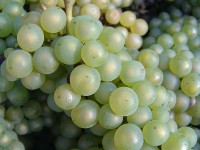 When I received the email earlier this week with the subject headline “DEUTZ 2011 HARVEST REPORT,” I couldn’t help but be reminded of the orange crop report from Trading Places. And while the price of orange juice has a bigger impact on the economy, the results of the Champagne harvest aren’t exactly trivial—last year close to 14 million bottles of bubbly were shipped to the United States alone. When the recession hit in 2008-09, more than a billion bottles were collecting dust in warehouses. So how was this past season’s yield?
When I received the email earlier this week with the subject headline “DEUTZ 2011 HARVEST REPORT,” I couldn’t help but be reminded of the orange crop report from Trading Places. And while the price of orange juice has a bigger impact on the economy, the results of the Champagne harvest aren’t exactly trivial—last year close to 14 million bottles of bubbly were shipped to the United States alone. When the recession hit in 2008-09, more than a billion bottles were collecting dust in warehouses. So how was this past season’s yield?
“Atypical” is how the Comite Champagne describes it. According to the report from Deutz, one of my favorite makers,
Late in May 2011, when flowering took place, the vine cycle was ahead of its normal state by about three weeks. At that point it looked as if we would be harvesting around the second half of August.
Then June and July were quite damp and cool: rain and occasional hail compensating for the overall water deficit. This enabled the plants to continue their growth, following nature’s whims. It also provoked sporadic patches of grey rot.
This dangerous trend was happily reversed by vastly improved weather in early August, which saw the sun shine again, bringing more seasonal temperatures.
The alternating weather pattern resulted in fruit set being irregular. Later on, the incidence of colour change in the grape bunches was therefore variable to the point where, on a single vine, some bunches coloured up rapidly whilst others remained green. Others were affected by grey rot which, fortunately, rarely got to the inner part of the bunches….
Despite careful management of spraying to protect the vines, which had resulted in them being in better-than-average shape prior to harvest, this was going to be a tricky one. Not only did the heat wave cause some of the pickers to suffer at the beginning, but the discrepancies in maturity levels between different plots, and even between individual vines, caused even more headaches!
Hence, until September 3rd, pickers were constantly moved from one plot to another with precise instructions and tasks. Secateurs had to be used with care and precision, almost like a surgeon’s scalpel, particularly in plots of Pinot Meunier and Pinot Noir affected by botrytis.
All these efforts were rewarded by the following results: average acid levels were maintained at 8.2 grams, and potential alcohol averaged 9.6°.
What this means, I suspect, is that 2011 will not have the makings of a classic vintage year. Oh well.
There are worse things the region has experienced, aside from heavy rains, droughts, frost, and a recession. When I visited Champagne in 2008, a winemaker pointed out on a map how the entire region was ripped apart during the First World War. I then asked him about the devastation from the German invasion in 1940. He replied, “Not much, really. It all happened so fast.”